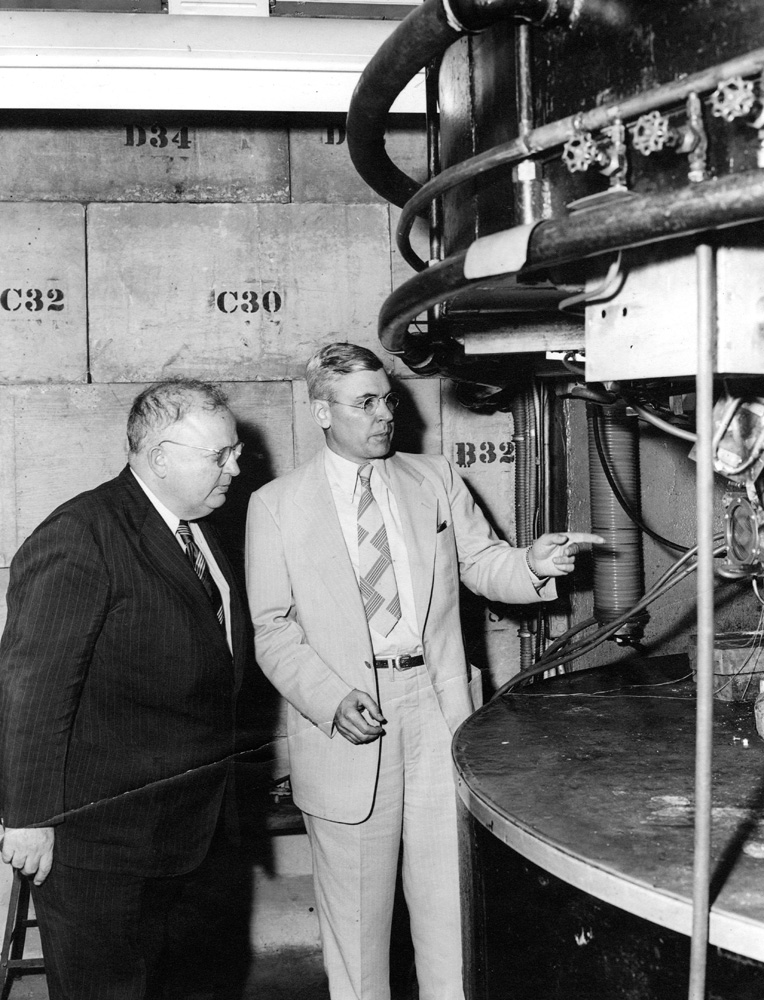Raymond Elliot Zirkle was a radiobiologist who worked at numerous Manhattan Project sites during World War II.
Zirkle was a principal investigator in the Manhattan Project’s biology division. Within the project, he focused on the comparative effects of living systems of fast and slow neutrons, beta rays, and gamma rays. Zirkle reported much of his research in the National Nuclear Energy Series; he was the health editor of this publication.
Zirkle worked at many of the Manhattan Project sites including Clinton Laboratories (Oak Ridge), the Radiation Laboratory at the University of California Berkeley, the National Cancer Institute in Bethesda, Maryland, and the Metallurgical Laboratory (“Met Lab”) at the University of Chicago. In his radiobiological research, Zirkle helped to define the acute lethal action of slow neutrons produced in the atomic piles.
Early Years
Raymond Elliot Zirkle was born on January 9, 1902 in Springfield, Illinois. He grew up on a farm in northern Oklahoma. Both of his parents were country school teachers.
As a young boy, his only source of education were one-room country schoolhouses in Oklahoma and southern Missouri. He gained exposure to the outside world and science through reading books. Serialized in a local Missouri newspaper, Sir Arthur Conan Doyle’s famous science-fiction book The Lost World was perhaps what sparked in Zirkle’s interest in science.
After moving from to West Plains from the farming areas of the Ozarks with his family, Zirkle attended West Plains High School. In school, he showed merit in mathematics and enrolled in a number of engineering classes. After graduating in 1919, he enlisted and served in the Missouri National Guard.
In 1924, he married Mary Evelyn Ramsey. Zirkle decided to continue his studies at the University of Missouri. He graduated in 1928 and was elected to Phi Beta Kappa and Sigma Xi, the university’s honorary scientific society. He remained at the University of Missouri to pursue a Ph.D. in botany, which he earned in 1932.
While working toward his Ph.D., also served as an assistant and later an instructor in the university’s Botany Department. For his thesis, Zirkle chose to work with alpha-particle radiation and fern spores, which would also become his main focus in his future experiments and work. In his thesis work, he observed alpha rays inhibited three different processes of fern spore germination: spore wall formation, chlorophyll development, and cell division.
After earning his Ph.D., he moved to Philadelphia to work for the Johnson Foundation for Medical Physics at the University of Pennsylvania. As a lecturer and fellow in biophysics, he focused on “the quantitative relationship between ionization per unit path of alpha particle and their biological effectiveness.” His quantitative work helped establish him as a leader in the field of radiation biology.
In 1938, Zirkle became an assistant professor of Biology at Bryn Mawr College. A few years later in 1940, he moved to the University of Indiana to become a professor of biology.
Later Years
In 1944, he became a professor at the University of Chicago. The following year, he also became the director of the Institute of Radiobiology and Biophysics. Throughout the late 1940s and early 1950s, Zirkle continued to theoretically and experimentally study the effects of radiation on living cells.
From 1952-1953, he was the president of the Radiation Research Society, and from 1954-1956, he was the counselor for the society. Zirkle co-founded the Biophysical Society and served as a counselor twice, first from 1957-1961 and second from 1964-1966.
Zirkle was a member of seven journal editorial boards and he served on several committees and study sections for radiobiology, biophysics and medical science research. In 1959, he was elected to the National Academy of Sciences. The next year in 1960, he was also elected to the American Philosophical Society.
He retired from the University of Chicago in the 1970s. Raymond Elliot Zirkle died on March 4, 1988 in Castle Rock, Colorado.
Scientific Contributions
Through his research, Zirkle provided the scientific community with new knowledge about the effects of high-energy radiations on cells and methods “for using radiation to ablate small regions and individual structures of cells.”
For example, his studies of alpha-particle irradiation of fern spores demonstrated that the cell’s nucleus is the most vulnerable to radiation damage and death. He also showed the importance of linear energy transfer within cells.
With his co-scientists, Zirkle was able to develop microbeam technology used for dissecting the functions of specific cell structures during mitotic chromosome movements.
For more information about Raymond Elliot Zirkle and his research, please see the following resource:





